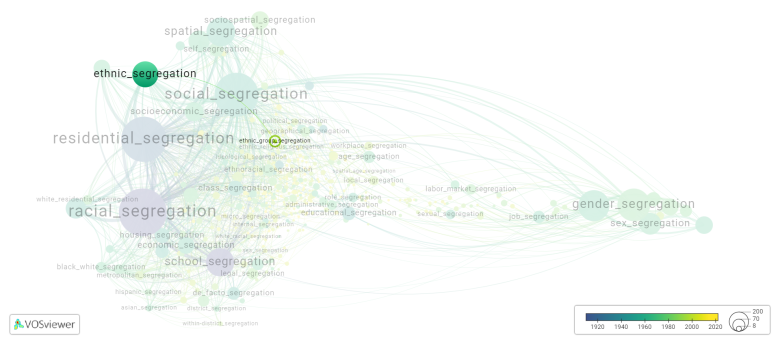Ethnic group segregation: Difference between revisions
(Creating page) |
(Creating page) |
||
| Line 14: | Line 14: | ||
Ethnic group segregation can have negative effects on society as a whole. It can perpetuate social inequalities, limit social mobility, and create barriers to integration and harmony among different ethnic groups. It is important for societies to actively work towards reducing and eliminating ethnic group segregation through policies and initiatives that promote equal access to housing, education, and employment opportunities for all individuals, regardless of their ethnic background. | Ethnic group segregation can have negative effects on society as a whole. It can perpetuate social inequalities, limit social mobility, and create barriers to integration and harmony among different ethnic groups. It is important for societies to actively work towards reducing and eliminating ethnic group segregation through policies and initiatives that promote equal access to housing, education, and employment opportunities for all individuals, regardless of their ethnic background. | ||
===== Synonyms ===== | ===== Synonyms ===== | ||
The following terms are synonymous with: | The following terms are synonymous with ethnic group segregation: | ||
ethnic groups segregation. | ethnic groups segregation. | ||
| Line 26: | Line 26: | ||
[[File:ethnic_group_segregation.png|780x780px]] | [[File:ethnic_group_segregation.png|780x780px]] | ||
This visualization is based on the study [[How_to_cite_Segregation_Wiki| The Multidisciplinary Landscape of Segregation Research]]. | |||
For the complete network of | For the complete network of interrelated segregation forms, please refer to: | ||
* | * [https://tinyurl.com/2235lkhw First year of publication] | ||
* | * [https://tinyurl.com/2d8wg5n3 Louvain clusters] | ||
* | * [https://tinyurl.com/223udk5r Betweenness centrality] | ||
* | * [https://tinyurl.com/244d8unz Disciplines in which segregation forms first emerged (Scopus database).] | ||
==References== | ==References== | ||
==Notes== | ==Notes== | ||
Revision as of 07:48, 10 October 2024
Date and country of first publication[1]
2003
United Kingdom
Definition
Ethnic group segregation refers to the social, economic, and political separation of different ethnic groups within a society. This separation can occur through various means, such as residential segregation, educational segregation, and employment segregation.
Residential segregation occurs when members of different ethnic groups live in separate neighborhoods or regions within a city or country. This can result from historical factors, economic disparities, or government policies. Residential segregation often leads to limited interaction and social integration between different ethnic groups and can perpetuate inequalities in access to resources and opportunities.
Educational segregation refers to the separation of students from different ethnic backgrounds into different schools or classrooms. This can occur through explicit policies or through de facto segregation resulting from residential patterns. Educational segregation can affect the quality of education available to different ethnic groups and can contribute to unequal outcomes in terms of academic achievement and future opportunities.
Employment segregation refers to the concentration of different ethnic groups in different industries, occupations, or levels of employment. This can result from historical patterns, discrimination, or social networks. Employment segregation can lead to unequal access to economic opportunities, lower wages, and limited career advancement for certain ethnic groups.
Ethnic group segregation can have negative effects on society as a whole. It can perpetuate social inequalities, limit social mobility, and create barriers to integration and harmony among different ethnic groups. It is important for societies to actively work towards reducing and eliminating ethnic group segregation through policies and initiatives that promote equal access to housing, education, and employment opportunities for all individuals, regardless of their ethnic background.
Synonyms
The following terms are synonymous with ethnic group segregation:
ethnic groups segregation.
References and literature addressing this segregation form under these synonymous terms can be found below.
See also
Related segregation forms
Ethnic group segregation is frequently discussed in the literature with the following segregation forms:
ethnic segregation, social segregation, residential segregation, hispanic residential segregation, urban residential segregation, workplace segregation

This visualization is based on the study The Multidisciplinary Landscape of Segregation Research.
For the complete network of interrelated segregation forms, please refer to:
References
Notes
- ↑ Date and country of first publication as informed by the Scopus database (December 2023).
At its current state, this definition has been generated by a Large Language Model (LLM) so far without review by an independent researcher or a member of the curating team of segregation experts that keep the Segregation Wiki online. While we strive for accuracy, we cannot guarantee its reliability, completeness and timeliness. Please use this content with caution and verify information as needed. Also, feel free to improve on the definition as you see fit, including the use of references and other informational resources. We value your input in enhancing the quality and accuracy of the definitions of segregation forms collectively offered in the Segregation Wiki ©.
Ethnic group segregation appears in the following literature
Blatchford P., Baines E., Pellegrini A. (2003). The social context of school playground games: Sex and ethnic differences, and changes over time after entry to junior school. British Journal of Developmental Psychology, 21(4), 481-505. https://doi.org/10.1348/026151003322535183
Forrest J., Poulsen M., Johnston R. (2006). A "multicultural model" of the spatial assimilation of ethnic minority groups in Australia's major immigrant receiving cities. Urban Geography, 27(5), 441-463. https://doi.org/10.2747/0272-3638.27.5.441
Sacks M.P. (2011). The Puerto Rican effect on Hispanic residential segregation: A study of the Hartford and Springfield metro areas in national perspective. Latino Studies, 9(1), 87-105. https://doi.org/10.1057/lst.2011.1
Manley D., Johnston R., Jones K. (2019). Decomposing Multi Level Ethnic Segregation in Auckland, New Zealand, 2001 2013: Segregation Intensity for Multiple Groups at Multiple Scales. Tijdschrift voor Economische en Sociale Geografie, 110(3), 319-338. Blackwell Publishing Ltd.https://doi.org/10.1111/tesg.12314
Sinitsyna A., Torpan K., Eamets R., Tammaru T. (2021). Overlap between industrial niching and workplace segregation: Role of immigration policy, culture and country of origin. Social Inclusion, 9(2), 179-191. Cogitatio Press.https://doi.org/10.17645/si.v9i2.3640
